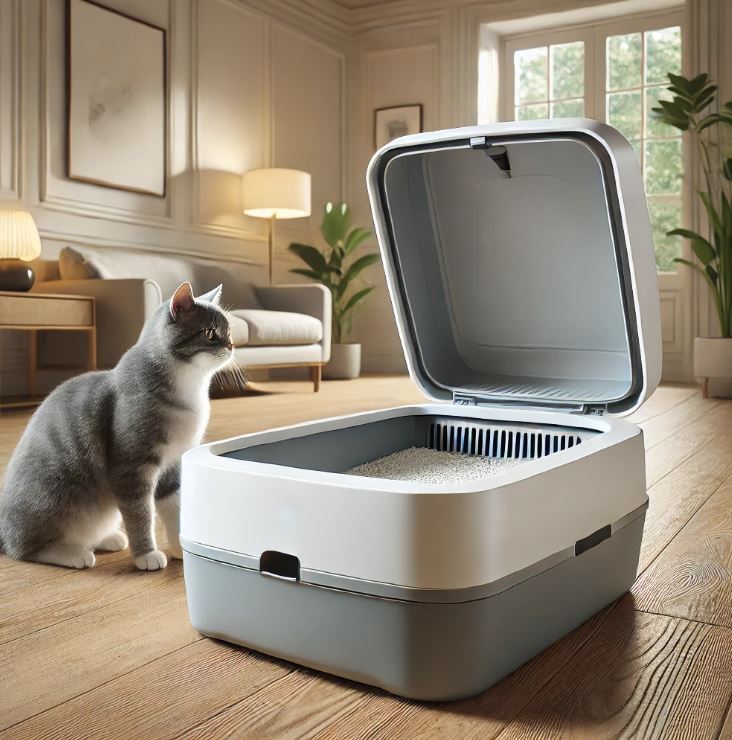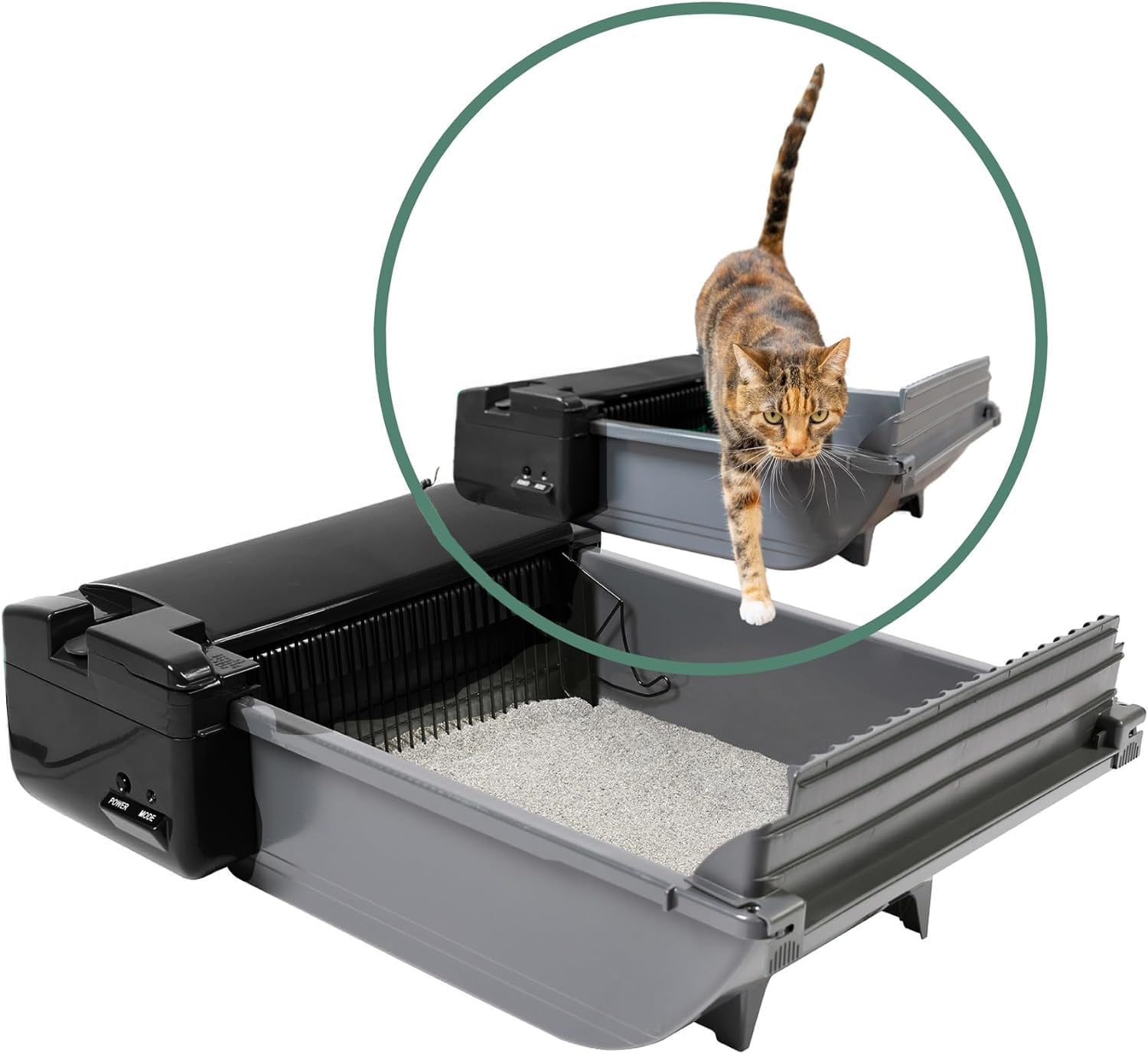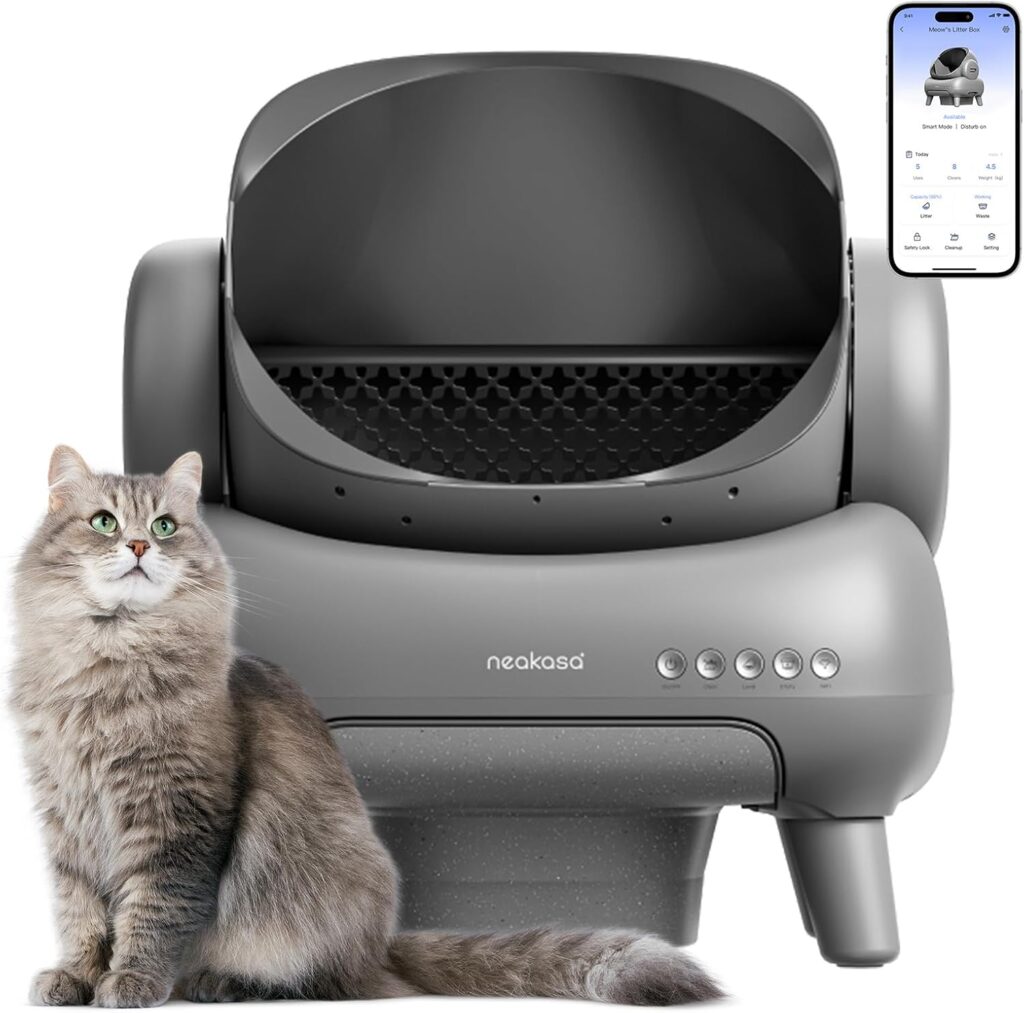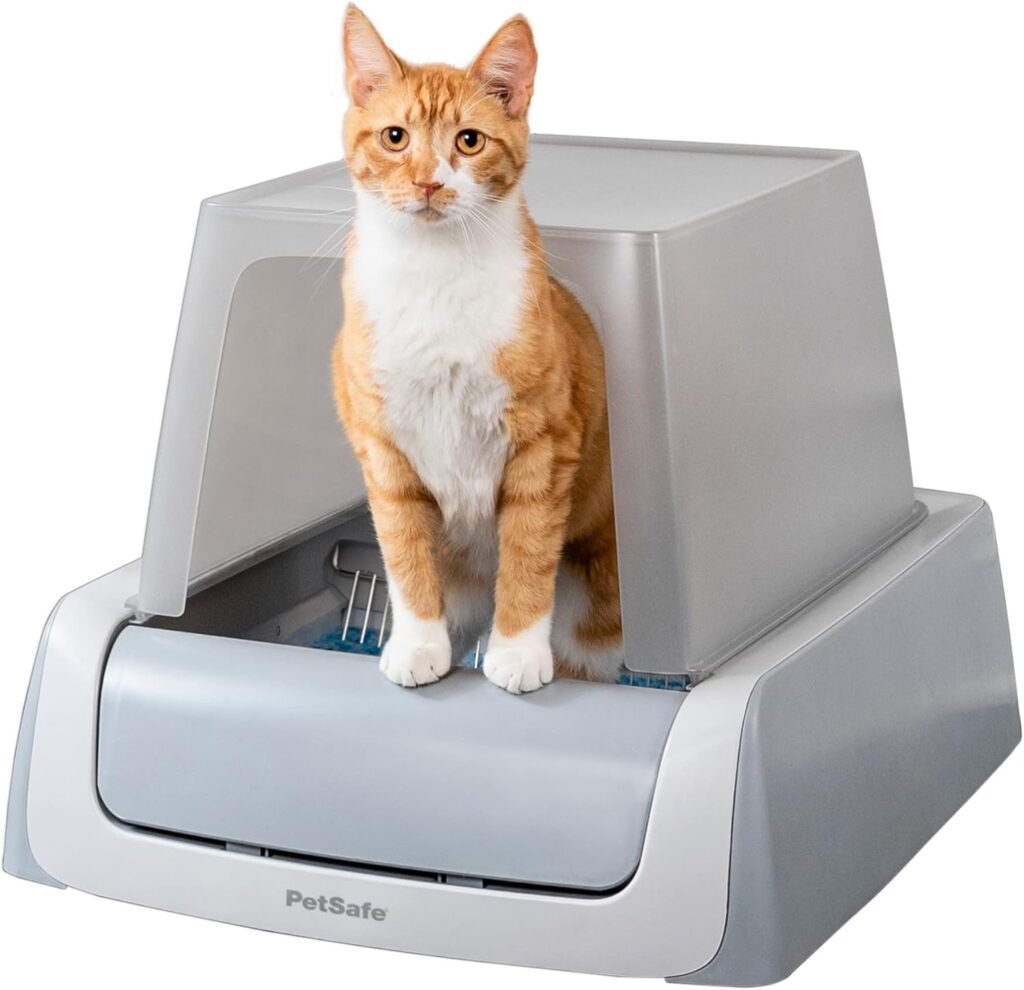I'm a participant in the Amazon Services LLC Associates Program, an affiliate advertising program designed to provide a means for me to earn fees by linking to Amazon.com and affiliated sites.
Finding the perfect automatic open litter box for your cat can be overwhelming with the myriad of options available. In this article, we explore the best automatic open litter box models available right now, providing insights into their features, performance, and which one might be the best fit for your needs. We also dive into comparisons, helping you make an informed decision.
Product | Price Range | Suitable for | Litter Type | App Connectivity | Noise Level | Price | |
|---|---|---|---|---|---|---|---|
High | Large cats/multi-cat | Clumping clay | Yes | Quiet | |||
High | Single cat/small space | Crystal litter only | Yes | Near-silent | |||
Budget-friendly | Single cat | Various types | No | Quiet |
Key Takeaways: Best Automatic Open Litter Box
- Ease of Use: All three models offer simple setup and maintenance, suitable for busy pet owners.
- Variety of Features: From app connectivity to quiet operation, these litter boxes provide a range of features to enhance convenience.
- Comparison Insights: Differences in price, type of litter used, and the technology integrated into each product influence their suitability for different cat owners.
Top Models for Automatic Open Litter Boxes
1. Neakasa M1 Open-Top Self-Cleaning Cat Litter Box
The Neakasa M1 is an ideal choice for cat owners looking for a straightforward, open-top design. It features a self-cleaning mechanism that activates shortly after your cat exits, ensuring a clean environment with minimal intervention. The M1 supports up to 33 pounds, making it perfect for larger cats. Its app provides real-time data and settings adjustments, enhancing user control. However, the higher entry point might require some cats to adjust.
2. PetSafe ScoopFree Smart Self-Cleaning Litter Box
The PetSafe ScoopFree stands out for its intuitive setup and minimal noise. Designed for open-top use, this litter box contains odors effectively while maintaining a sleek, unobtrusive profile. The accompanying app tracks litter box activity and allows users to set reminders for litter changes, providing real-time updates on your cat’s habits. This model works best with crystal litter and is ideal for those looking for a quiet, efficient solution.
3. Pet Zone Smart Scoop Automatic Litter Box
For those on a budget, the Pet Zone Smart Scoop is a fantastic entry-level option. It uses a raking system to remove waste 30 minutes after your cat uses the box, minimizing disturbances while ensuring cleanliness. The quiet operation and affordability make it an excellent choice for pet owners seeking a reliable and straightforward self-cleaning option without high-tech add-ons.
Pros and Cons of Each Model
Model | Pros | Cons |
|---|---|---|
Neakasa M1 | Supports large cats, easy app integration, efficient odor control | High entry point, may require adaptation for some cats |
PetSafe ScoopFree | Near-silent operation, excellent odor control, smart app features | Only works with crystal litter, requires lifting for waste disposal |
Pet Zone Smart Scoop | Affordable, quiet operation, simple maintenance | Limited features, open-top style may leave odors more exposed |
Major Differences Between the Models
- Price Range: The Neakasa M1 and PetSafe ScoopFree are premium models, offering advanced app integration and high-quality build, while the Pet Zone Smart Scoop provides a budget-friendly option with basic functionality.
- Litter Compatibility: PetSafe ScoopFree is limited to crystal litter, which may be less versatile compared to the Neakasa and Pet Zone models that work with various litter types.
- Design and Size: The Neakasa M1 is designed specifically for larger cats, making it a suitable option for multi-cat households. In contrast, the PetSafe and Pet Zone models focus on quieter operation and smaller footprints, ideal for single-cat homes or apartments.
Product | Price Range | Suitable for | Litter Type | App Connectivity | Noise Level | Price | |
|---|---|---|---|---|---|---|---|
High | Large cats/multi-cat | Clumping clay | Yes | Quiet | |||
High | Single cat/small space | Crystal litter only | Yes | Near-silent | |||
Budget-friendly | Single cat | Various types | No | Quiet |
Recent Developments in the Automatic Litter Box Market
The market for automatic litter boxes continues to evolve with new technology and designs:
- AI Monitoring: Companies like Whisker Lab are integrating AI technology to provide more detailed health tracking for cats, detecting changes in weight or behavior patterns.
- Sustainability Initiatives: Brands such as EcoCat Solutions are developing eco-friendly designs that use recycled materials and biodegradable waste trays.
- Enhanced Connectivity: Some models now offer compatibility with smart home systems, such as Alexa and Google Home, allowing owners to receive real-time alerts and control settings using voice commands.
Top Experts and Entities in the Field
- Whisker Lab: Leading the industry with AI-powered health monitoring features, Whisker Lab is at the forefront of innovation in automatic litter boxes.
- EcoCat Solutions: Known for their sustainable designs, EcoCat Solutions focuses on reducing the carbon footprint of pet products.
- PetTech Innovations: This entity specializes in integrating smart home compatibility, making litter boxes more convenient for tech-savvy pet owners.
Other Interesting Articles
- Furbo Cat Treats: Which Treats Work With Furbo?
- Furbo Mini vs Furbo 360: Best Furbo Treat Dispenser
- Best Dog Camera Treat Dispenser: Which One Wins?
- Best Cat Dry Food for Indoor Cats
Author
Written by PetsPal, an expert in pet care products and reviews. For more insights on the latest in pet technology, visit PetsPal.
Setup and Installation Tips
Setting up an automatic open litter box can vary depending on the model, but most share similar steps to ensure optimal performance and safety. Here are some general tips to get started:
- Unbox and Verify Components: Before assembly, make sure all necessary components, such as the waste tray, rake mechanism, power adapter, and any instruction manuals, are included.
- Choose the Right Location: Place the litter box on a flat, stable surface in a low-traffic area to give your cat a sense of security and privacy. Ensure the space has access to a power outlet if the device requires it.
- Fill the Litter: Depending on the model, you may need to use specific litter types, such as clumping or crystal varieties. Fill the litter tray according to the manufacturer’s recommended level to avoid malfunctioning during the cleaning cycle.
- Connect to Power and the App: Plug in the device and follow the setup instructions in the user manual. For models with smart features, download the compatible app, connect via Bluetooth or Wi-Fi, and customize the settings like cleaning schedules and notifications.
- Introduce Your Cat Slowly: Cats may take time to adjust to new litter boxes. Consider placing familiar items like toys or treats near the litter box, gradually encouraging your cat to use it.
Safety Features
Safety is a priority when it comes to automatic open litter boxes, and many models incorporate innovative features to protect your pets:
- Motion Sensors: Most automatic litter boxes are equipped with motion sensors that detect when your cat enters and exits the box. This ensures that the cleaning mechanism only activates when the box is unoccupied, preventing any risk of injury.
- Anti-Pinch Technology: Some models include anti-pinch designs for their raking mechanisms. If an obstruction is detected, the rake halts immediately to avoid harming the cat.
- Emergency Stop Function: High-end models offer an emergency stop function, allowing users to pause the cleaning cycle through a button on the device or via a smartphone app in case of any malfunction.
- Stability and Non-Slip Base: To prevent tipping or shifting during use, many automatic litter boxes feature non-slip bases or additional support legs to keep the device stable.
- Low Voltage Operation: To minimize electrical risks, some models use low voltage for their operation, ensuring safety in case of accidental contact with water or other substances.
Maintenance and Cleaning Tips
Proper maintenance is essential for keeping automatic open litter boxes functioning efficiently and extending their lifespan. Here are some practical tips:
- Empty Waste Trays Regularly: Depending on usage, waste trays should be emptied every 2-3 days. Neglecting this can lead to odor build-up and affect the litter box’s performance.
- Clean Sensors and Rake Mechanisms: Wipe down sensors and rake mechanisms with a damp cloth to remove any litter dust or debris. Keeping these components clean ensures accurate functioning and reduces the risk of malfunctions.
- Deep Clean Monthly: At least once a month, disassemble the litter box and wash all removable parts using pet-safe cleaning products. Avoid using harsh chemicals that may leave residues harmful to your cat.
- Use Recommended Litter: Each model typically specifies the type of litter that works best. Adhering to these recommendations can prevent clogs and ensure optimal performance.
- Monitor App Alerts: For models with app integration, pay attention to alerts indicating when maintenance is required. The app can provide reminders for deep cleaning, waste tray emptying, or litter refilling.
Frequently Asked Questions (FAQ)
Q: How do I know when to empty the waste compartment?
A: Many models come with indicators or app alerts that notify you when the waste compartment is full. If your model doesn’t have this feature, it’s generally advisable to check and empty it every 2-3 days.
Q: What type of litter should I use?
A: It depends on the model. Some automatic litter boxes are designed for clumping clay litter, while others work specifically with crystal or biodegradable litters. Always check the manufacturer’s guidelines to ensure compatibility.
Q: My cat is not using the litter box. What should I do?
A: Cats may take time to adapt to new litter boxes. Place the box in a quiet, familiar spot and use familiar objects or treats to encourage your cat to explore. Gradual introduction usually helps them acclimate.
Q: Can I use the litter box for multiple cats?
A: Some models are designed to accommodate multiple cats, but usage frequency will increase. Be prepared to empty the waste compartment more often and keep an eye on cleanliness to maintain a healthy environment for all cats.
Q: How do I clean the sensors without damaging them?
A: Gently wipe the sensors with a soft, damp cloth. Avoid using excessive water or harsh chemicals, as these can damage the electronics. Regular cleaning ensures the sensors function properly and keeps the system accurate.







